Algae growth in freshwater aquariums can be a frustrating ordeal for aquarists, leading to murky waters and unsightly tank conditions. Despite their nuisance, most algae species don’t directly harm fish, but they often indicate an imbalance in the tank environment. By understanding the causes of algae blooms and implementing proper maintenance practices, such as managing water and light parameters, aquarists can effectively combat algae overgrowth, come find out more.

Several times in the past I’ve experienced different types of freshwater aquarium algae blooms which had been secretly growing in my tank.
Even though they may seem unpleasant, these microorganisms don’t pose a serious threat to aquatic animals.
In fact, there are many fish species and invertebrates that will eat some of them with joy.
Furthermore, their buildup can be easily prevented as long as you balance the amount of light and food in your tank.
In this post, I will help you identify the different types of algae, and give you some tips on how to get rid of them.
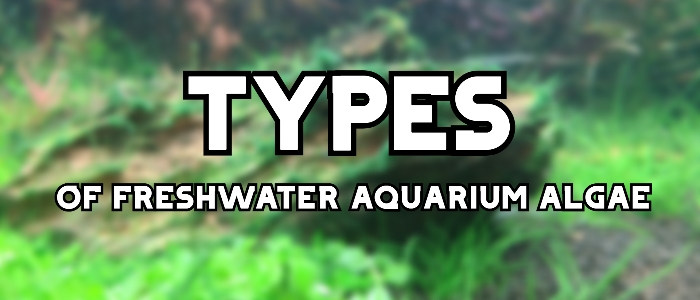
What causes algae growth in a fish tank?
Some time ago a friend I’d been teaching how to keep freshwater aquariums reached out to me, worried about the green stuff growing in his betta tank.
He expressed that no matter what he did or how much he cleaned it, it kept growing back and the plants in his tank seemed to be suffering.
After I gave him a quick rundown on all the different types of freshwater aquarium algae, I decided to write an article that will help other aquarists who are in a similar situation.
So before moving on I first need to explain why algae may be growing in your fish tank and where it came from.
Here’s why there’s algae growth in your fish tank:
Algae are photosynthetic organisms which require a source of light and organic nutrients in order to grow. When they’re present in aquarium systems that are overexposed to light or contain decaying organic matter, algae take advantage of the excess resources and start to multiply.
Newly established tanks are often prone to algae blooms because of some common beginner mistakes such as overfeeding pet fish. In such scenarios, the leftover fish food ends up at the bottom of the tank where it begins to decompose.
Without proper maintenance, the decaying waste gets transformed into nitrate, which then fuels algae growth. Apart from nitrate, algae also turn to phosphates as a source of energy. There are many factors that could elevate the phosphate levels in an aquarium, but the culprit in most cases turns out to be tap water.
If you suspect that a recent water change might be responsible for your current predicament, then it would be a good idea to measure the phosphate levels with a water test kit. Another common mistake that leads to the development of algae in a fish tank is improper exposure to light.
Aquatic ecosystems need to be kept in a state of equilibrium in order to support life.
Even a slight shift in the established parameters can send the entire system spiraling into disarray.
When the light provided to an aquarium isn’t balanced with the nutrients and Carbon Dioxide (CO2) available, the algae begins to multiply by taking advantage of the excess resources. However, this is only part of the equation.
In order to grow, plants need light to complete photosynthesis, so they can consume the CO2 and nutrients in the aquarium and produce their own food.
If your aquarium gets too much light, but not enough nutrients, plants often suffer growth deficiencies and start to decay.
In effect, these circumstances create a perfect breeding ground for algae.
What are the different types of freshwater aquarium algae?
To reduce the algae in your fish tank to unnoticeable amounts you first need to be familiar with the type you’re fighting.
There are seven common types of freshwater algae that can be found in a home aquarium:
Hair Algae

The term Hair algae refers to a number of different algae types that share a similar stringy structure.
Green Hair Algae and Staghorn algae are the two most common ones that usually plague home aquariums.
The first one forms a soft, green, fuzzy layer across just about anything it can possibly grow on.
Driftwood, rocks, decorations, and substrate are likely to be covered in the moss-like stuff if it’s left to grow unchecked. The good news is that a lot of cleaner fish love to munch on Green Hair Algae.
Provided your tank is big enough, arming your system with even a single Siamese Algae Eater will significantly reduce the level of algal growth. As you can guess by their name, these fish are a blight to algae and will stop at nothing to get their snack.
Staghorn algae on the other hand grow in gray strands and are often found when there’s an abundance of iron in the water.
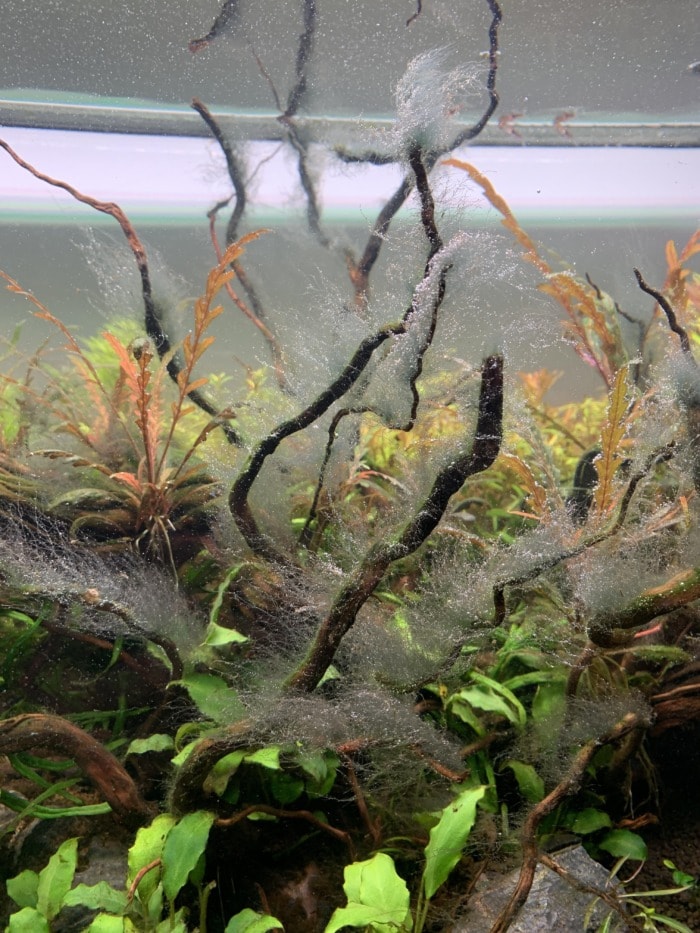
If you’ve been fertilizing your tank with liquid fertilizers shortly before the bloom, this is the most likely cause. To find out whether that’s the case, use a water test kit to measure the amount of iron in your aquarium water.
Under normal circumstances, you should have no more than 0.1 mg/l iron; anything above this reading indicates there’s an overabundance of iron in the tank.
Unlike Green Hair Algae, there aren’t many fish species that will eat Staghorn algae so the best way to deal with it is to adjust the amount of fertilizer you use.
Finally, another popular type of hair algae that plagues home aquariums would be filamentous algae.
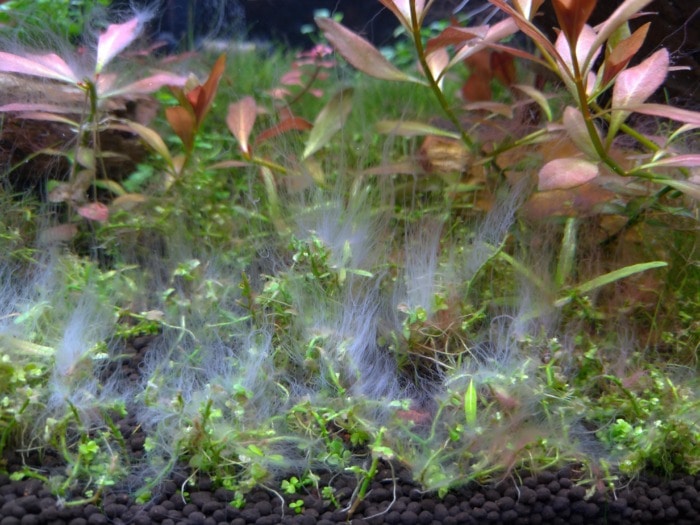
Filamentous algae grow in long fine threads and are very soft to the touch, unlike Staghorn algae. The filaments of this type of hair algae can have a green or white color.
Green Water
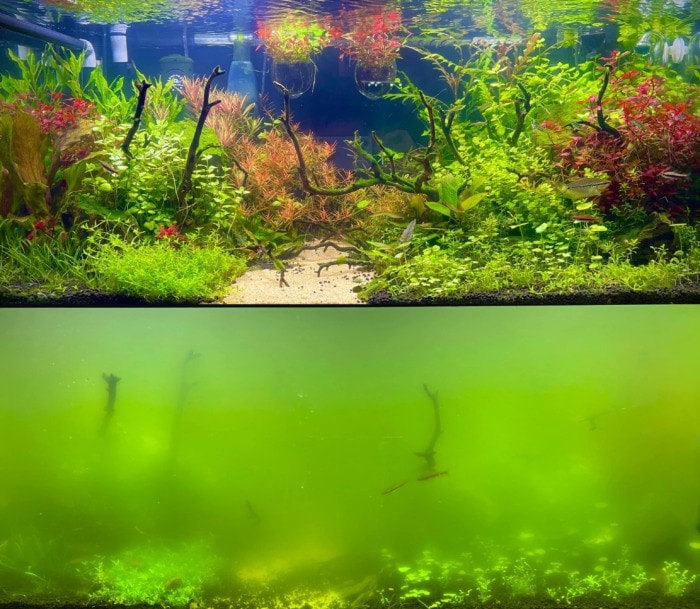
Does your aquarium water look greener than usual?
If that’s the case, then say hello to the millions of algae spores that have been secretly festering while you were asleep.
Generally, these spores are present in every aquarium system but become noticeable only when there’s a drastic increase in their population during a bloom.
Green water starts out hazy but can become so thick that you can’t see through your tank anymore.
While not necessarily dangerous, it does ruin the aesthetics of your aquarium.
After all, what’s the point of having a tank full of exotic fish when you can’t even see them?
These algae can cloud your tank due to several different reasons such as too much light or an overabundance of nutrients.
In these cases, lowering the amount of food you feed to your fish and reducing the blue spectrum on your aquarium lighting can help resolve your issue. If you’re dealing with an algae bloom, however, it would be a better idea to check some of the other methods for control discussed here.
It’s good to note that in some circumstances, green water might appear more yellow than green.
This usually happens during the daytime, when the tank is exposed to light.
White Algae
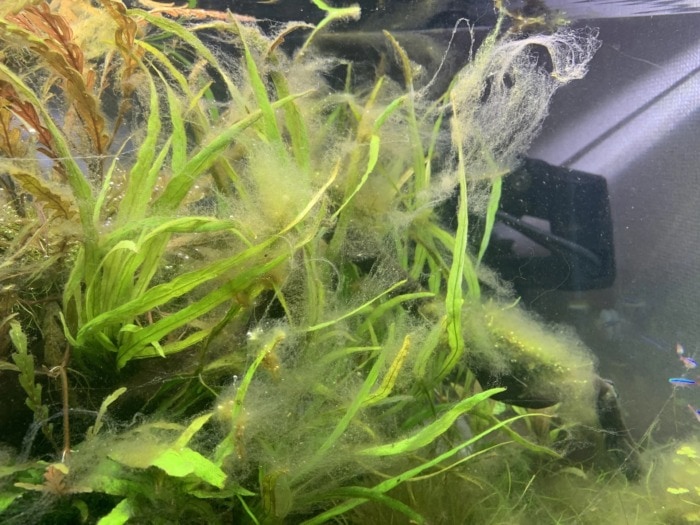
Identifying white algae can be a bit difficult since it often gets confused with water molds.
In most cases, the term “white algae” is used to refer to a subtype of Green Hair Algae known as Leptomitus lacteus.
These algae typically cover aquarium surfaces in white, stringy filaments that can be quite tough to deal with.
Water molds, on the other hand, are caused by microscopic aquatic fungi that can engulf your entire water column.
Unlike the hair-like structure of white algae, water molds grow in fuzzy white patches all over the aquarium.
It often looks like a slimy white web that spreads out across the tank.
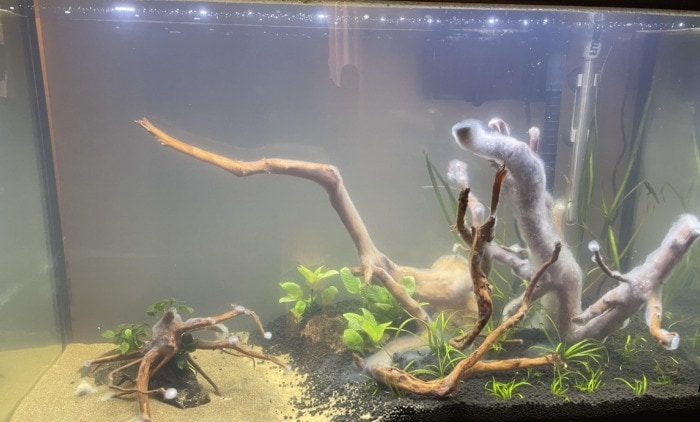
Here’s a side-by-side comparison:
Both of these aquarium pests are typically caused by excessive amounts of freely available nutrients.
However, water molds might also appear in your fish tank if you add a new decorative piece.
In these cases, the water mold latches on the dead organic matter carried by the decoration.
Fortunately, such outbreaks last relatively short and get resolved by themselves.
Another thing you should keep in mind is that water molds thrive in acidic water, so it would be a good idea to pull out a test kit if you’re dealing with an outbreak.
Even though they’re mostly harmless, some forms of mold might try to carry over to fish and cause an infection. You can identify fungal infections in fish by the white patches that appear on the body and fins of the diseased specimen.
If left untreated, these conditions might end up killing the diseased fish. I have a resource that will help you learn how to eradicate white water molds from your aquarium.
Black Beard Algae
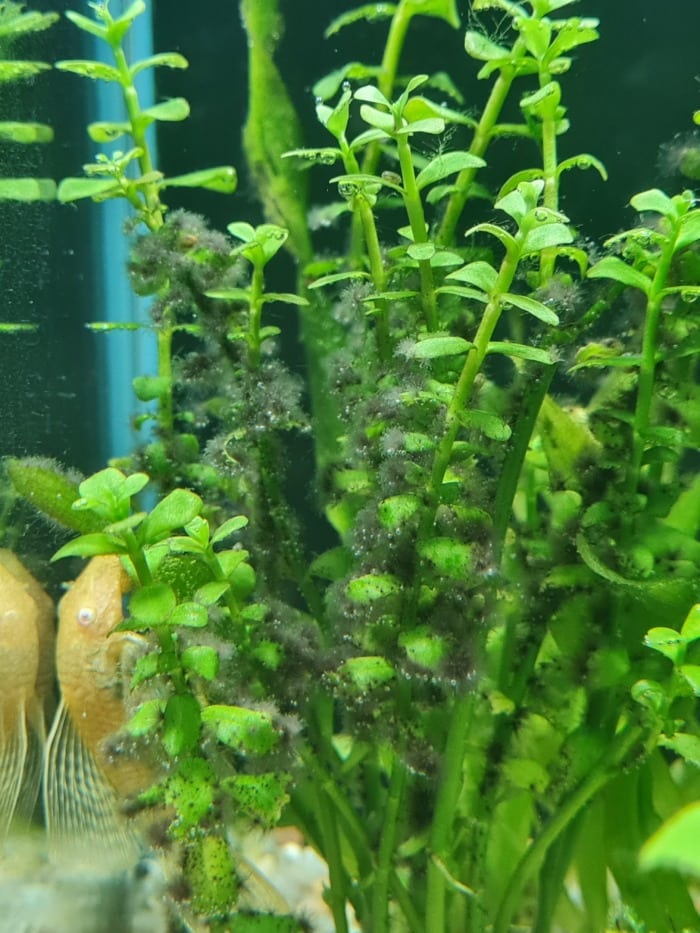
You don’t need more than a single glance to realize Black Beard Algae is the stuff of nightmares.
I must admit that the first time I saw it growing in my tank, it made my skin crawl.
There’s just something about its black, hair-like texture that seems uncanny and out of place.
Maybe it’s because we never imagine certain mammalian features to be present in an aquatic organism.

Anyways, Black Beard Algae is actually a type of red algae belonging to the Rhodophytes.
This, however, doesn’t stop it from being bluish or greenish on some occasions.
True to what you might expect from its appearance, this aquatic pest is so persistent that it may take months to remove if you follow conventional strategies.
Fortunately, there are a few ways that can help you deal with Black Beard Algae in a short timeframe.
Since it grows in environments rich in phosphate, most of these methods are centered around regulating the levels of phosphate in your tank.
Suggested read: How to permanently get rid of black algae in your aquarium?
Green Spot Algae
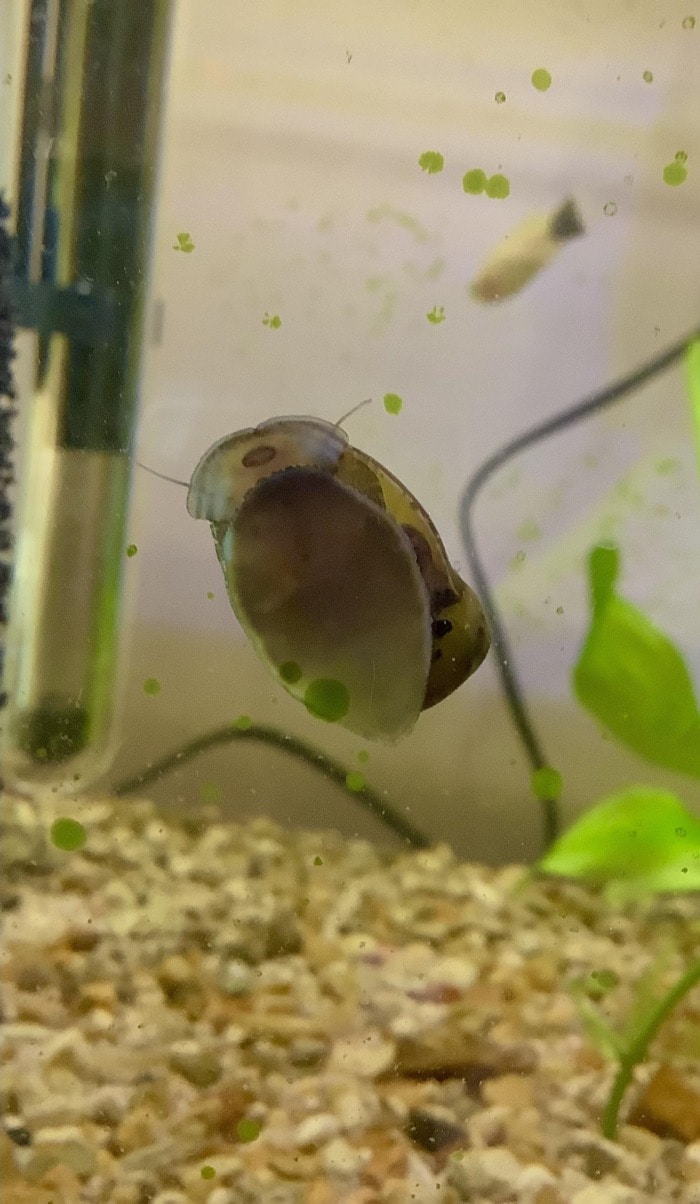
Dealing with Green Spot Algae can be a tough nut to crack.
Even though it shares some similarities with other aquarium algae, eradicating it requires some unconventional approaches.
It initially appears as small green specks on aquarium surfaces, but after a while, it spreads to plant leaves.
If you catch the spread early on, you could easily remove it from the walls with an algae scrubber.
Alternatively, you can also introduce Nerite snails which will take the burden of manual labor off your hands.
Unfortunately, both of these methods won’t work if GSA has already reached the leaves of your aquarium plants.
Strangely enough, one thing which might help you get rid of it would be to increase the phosphate levels and CO2 in your system.
Many fellow aquarists have shared how they vanquished Green Spot Algae by simply increasing the phosphates in their tank.
However, you should tread lightly if you go down this route as the excess phosphates might fuel the growth of other algae.
Usually, the best way to avoid that is to have lots of plants in your aquarium.
Anyhow, one thing Green Spot algae have in common with some of the other types is they thrive in systems overexposed to light.
If none of the other methods works, then try adjusting the blue spectrum of your aquarium lighting to see whether it reduces the growth of Green Spot Algae.
Brown Diatom Algae
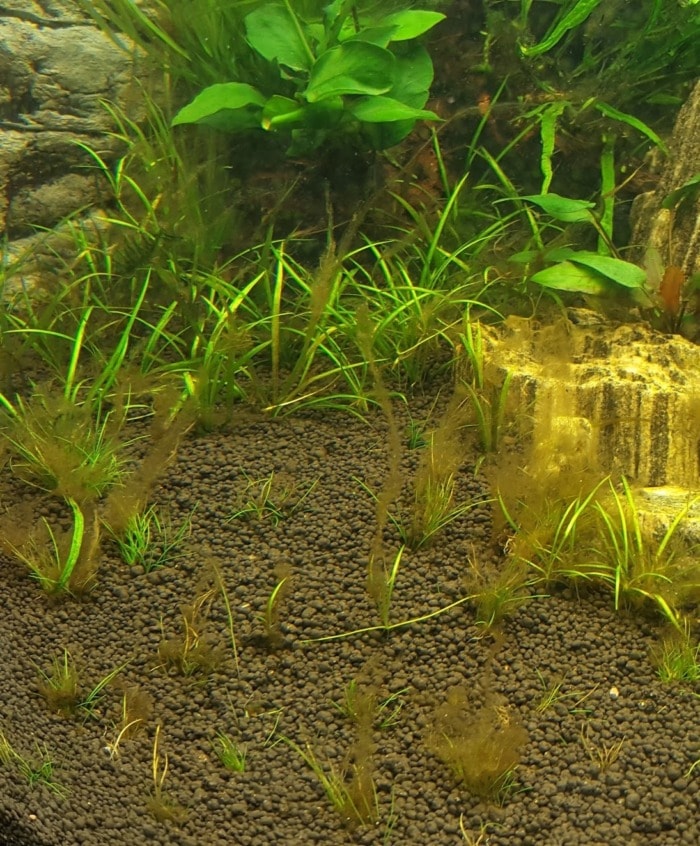
Brown algae consist of what’s known as “diatoms” and can grow in both freshwater and saltwater aquariums.
A diatom is a single-celled alga where the walls of its cell are composed of silica. Brown algae are most commonly found on walls, substrates, plants, and other aquarium surfaces.
This type of algae is commonly seen in newly set up planted aquariums without an established nitrogen cycle.
Because of this brown algae are one of the most popular algae found in home aquariums.
Once the nitrogen cycle gets stabilized, however, the brown algae typically go away.
Diatoms are very dependent on phosphates in their environment.

Sometimes, a partial water change can also lead to an outbreak of brown algae.
This typically happens in parts of the world where they still use old lead plumbing.
Since lead is toxic, water facilities use phosphates to neutralize its effects and make tap water safe.
If you suspect a recent water change as the possible culprit, it would be a good idea to test your water.
Under normal circumstances, the test results shouldn’t show more than 1 ppm of phosphates.
While it won’t affect your fish, brown algae are not a pleasant sight to look at and can harm your plants by blocking their incoming light.
Fortunately, their soft texture makes these algae easy to remove manually and there are many cleaner fish that like to eat them.
If some of your plants are already covered in Brown Diatom Algae, you can use a toothbrush to gently scrub it off.
Blue-Green Algae
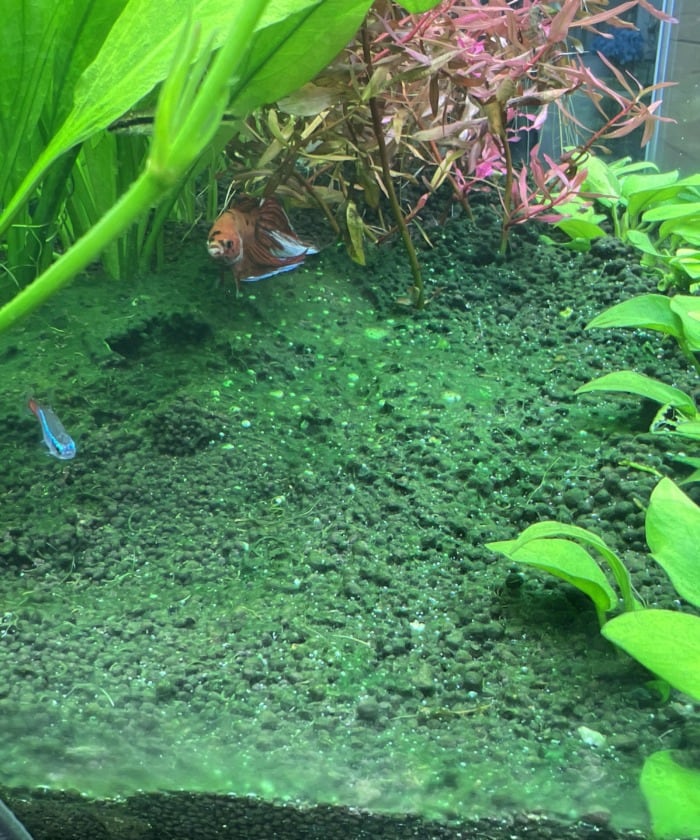
Despite its name, Blue-Green Algae is actually a group of Cyanobacteria that usually appear in still bodies of water with warm temperatures.
It has the appearance of blue slime which covers the surfaces in the aquarium, including live plants.
Cyanobacteria use photosynthesis as their source of energy.
For this reason, these bacteria can suffocate your aquatic plants if they cover them.
Other than that Blue-Green algae is not dangerous to an aquarium.
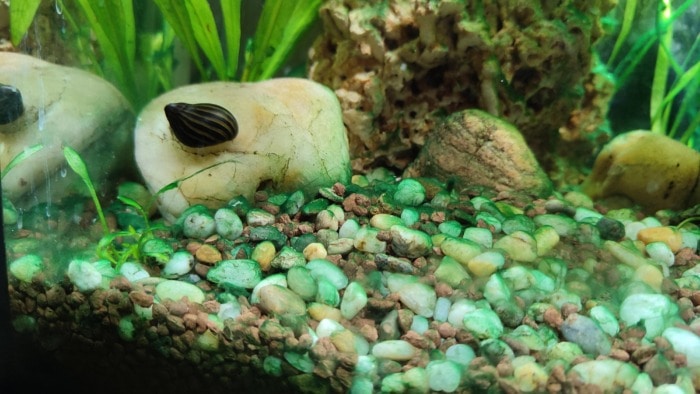
What makes me not want them in my aquariums is the overall dirty look they give to my tanks.
Not pleasant to look at, the slimy Blue-Green algae also give off a foul smell to my aquarium water.
A good way to deal with Cyanobacteria is by increasing the water current inside the tank and reducing the incoming light.
The water current is easily increased by adding a powerhead to the tank or by ramping up your canister filter’s flow rate.
Is algae bad for your aquarium fish?
While most freshwater macroalgae don’t harm pet fish directly, they typically indicate that there’s something amiss with the aquarium system.
Usually some sort of imbalance.
If left untreated, some of these imbalances could eventually lead to a full-fledged bloom of microalgae which can negatively impact fish.
During a green water bloom, the levels of dissolved oxygen in the aquarium system begin to drop at night.
That’s because green algae spores consume oxygen during night time and in excessive numbers, they can cause problems to your fish.
If this coincides with a bacterial bloom, which can often be the case, there’s a high chance the fish will lose the battle for oxygen and end up suffocating.
Even though small amounts of algae won’t affect your fish, they shouldn’t be taken lightly.
In some extreme cases, all it takes is one night before the few green specks in your aquarium turn into a nightmarish goo.
How to get rid of algal growth in your aquarium?
Getting rid of the growing algae in your aquarium is often as simple as making sure the system’s being cared for properly.
An aquatic environment with the right balance of lighting and nutrients shouldn’t be overrun with nuisance algae.
There are several ways to get rid of an outbreak, from water management to medications and adding algae eaters to the tank:
- Manage the water parameters.
One of the first things to check when you notice algae growing out of control is the level of nutrients and minerals present in the water.
Elevated nitrate and phosphate levels are often responsible for algal growth.
Author’s Note: You may want to check your tap water’s mineral content as well to see if that’s the source of the imbalance. Changing out the aquarium water doesn’t matter if the new water is still rich in nutrients that algae feed on.
A tank that receives too much light is going to encourage abundant algae blooms.
Limit your aquarium’s lighting to between 7 and 8 hours per day.
Anything else is excessive for an aquarium and is asking for algae trouble.
Since algae often thrive with nitrate, a byproduct of ammonia in the nitrogen cycle, keeping your tank clean can help reduce this. Feed your fish the right amount, remove debris, and uneaten fish food promptly before it has a chance to add ammonia to the water.
If you do see algae in your tank, clean it up as soon as you see it.
Also, remember to do regular water changes to keep Nitrate levels down.
To prevent algae spores from entering your aquarium in the first place, you can clean new aquarium plants and other decors with a bleach solution.
Take your new plants and let them soak for up to 10 minutes in a solution of 5% bleach, which is 19 parts of water to 1 part bleach.
This will kill the algae spores that may have been attached to the plant before they enter your aquarium.
Author’s note: Always thoroughly rinse your plants off in dechlorinated clean water after giving them a bleach bath. Not doing so can harm or even kill your fish and throw off your delicate aquatic ecosystem.
An ultraviolet water sterilizer uses UV lights to kill off any algae spores that may be floating in the water. This can be an effective method to clear out green clouds of algae threatening to take over your tank.
Diatom filters are a good option for stubborn brown algae growth because they trap the algae cells as water passes through them.
This can be used in addition to a regular canister filter, and as an added bonus, your water will look pristinely clean with one of these runnings.
There are several water conditioners for algae control on the market that can be used to kill off stubborn algae growth in a freshwater fish tank.
Author’s note: I personally don’t recommend this method, but I’m obligated to mention it. Algaecides are just not very fish-friendly and accidents can happen.
Many fish and invertebrates will happily eat most kinds of algae. These cleaner critters are known as the Freshwater Clean-up Crew of the aquarium world. Having such algae eaters in your tank is a great way to help keep the algae growth down.
Other aquatic pets will happily eat algae, including several shrimp and snails.
Adding these can help keep the algae growth under control, and as a perk, they’re a lot of fun to watch doing so!

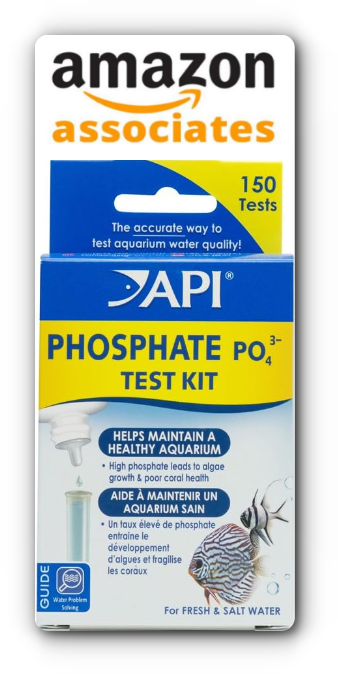
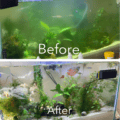




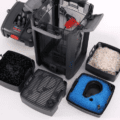


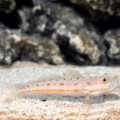
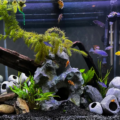
1 thought on “7 Common types of freshwater aquarium algae (illustrated)”